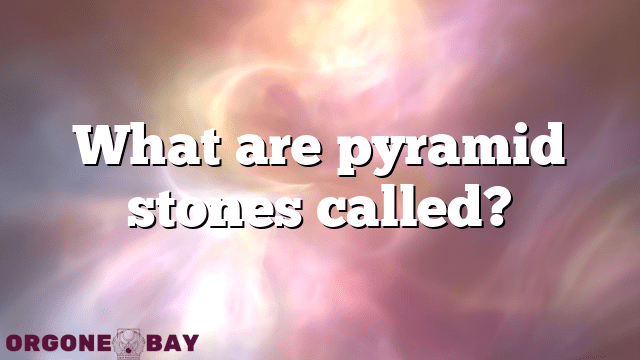Crystal Structures & Grids
What are pyramid stones called?
Pyramid stones that sit atop an Egyptian pyramid or obelisk are known as pyramidia or the plural version, pyramidions. These capstones are often made of precious materials, such as gold or granite, and were thought to serve as a link between earth and the heavens. Beyond their use in architecture, pyramidia hold a special significance in the crystal spirituality community. Many believe that incorporating pyramid-shaped stones into one’s spiritual practice can have a range of beneficial effects. Some examples include:
• Amplifying energy: Due to the shape of a pyramid, energy is believed to be concentrated and magnified within its walls.
• Enhancing meditation: The focused energy within a pyramid-shaped crystal is thought to encourage concentration and deepen meditation practices.
• Balancing chakras: When placed on or near the body, a pyramid-shaped stone is said to help balance energy centers, or chakras, within the body.
• Strengthening intention: Pyramidia are often thought to be tools for manifestation, helping to strengthen intention and focus energy towards specific goals.
Overall, while pyramidia hold a great deal of historical and cultural significance, they also have a place within the modern context of crystal spirituality. Incorporating pyramid-shaped stones into one’s spiritual practice can offer a range of benefits that are both meaningful and accessible.
Table Of Contents
Pyramid Stones: Definition and Concept
Pyramid stones or pyramidions, as they are called, are the topmost part or the capstone of the Egyptian pyramid or an obelisk. These stones were placed at the top of the pyramid or obelisk as a marker of the monument’s completion. Pyramidions were often made of precious stones, such as granite, limestone, or Diorite. The stones were not only used as a decorative feature but were also imbued with symbolic and spiritual significance.
History of Pyramid Stones
The ancient Egyptians built pyramids as tombs for their pharaohs and queens. The pyramids were constructed as monumental tributes to the ruling monarchs and were intended to last forever. The pyramidion was the last stone added to the structure, completing the building process. Pyramidions were often covered with inscriptions or images of gods and goddesses. The ancient Egyptians believed that this would protect the burial chamber from harm and offer eternal protection for the pharaoh’s spirit.
The Function of Pyramid Stones
One theory suggests that the pyramidion was used to reflect the sun’s rays back into space, symbolizing the pharaoh’s ascent to heaven. Another theory suggests that they were used to facilitate the communication between the pharaoh’s spirit and his or her gods. It was also believed that the pyramidion acted as a beacon for the deceased pharaoh’s spirit, guiding him or her to the afterlife.
The Materials Used for Pyramid Stones
Pyramidions were often made of the same material used to build the pyramid itself. The materials used depended on the availability of stones in the area. Granite and limestone were commonly used, while Diorite was reserved for the pharaoh’s most important monuments. Some pyramidions were covered with gold or bronze as a symbol of the pharaoh’s power and status.
Pyramid Stone Shape and Design
Pyramidions were usually small compared to the size of the pyramid they were placed on. They were typically made in a pyramid shape, with an angled top covered in inscriptions or carvings. The inscriptions or carvings were usually of gods, goddesses, hieroglyphs, or images of the pharaoh himself. The pyramidion’s design was considered an essential component of the monument’s overall construction.
Pyramid Stone Symbolism
Pyramid stones were symbolic of the pharaoh’s divine power and his or her spiritual journey to the afterlife. The pyramidion’s four edges also represented the cardinal directions, north, south, east, and west. They were believed to align with the stars, reflecting the pharaoh’s power over the entire world.
The Role of Pyramid Stones in Spirituality
Today, pyramid stones are still believed to hold spiritual significance. Many believe that they have the power to enhance spiritual awakening, psychic ability, or meditation practices. Pyramid stones are used in spiritual practices to help align the chakras or energy centers, promoting balance and well-being. Some also believe that pyramid stones can amplify the energy of other stones or crystals, enhancing their healing properties.
How to Use Pyramid Stones in Healing Practices
To use pyramid stones in healing practices, place the pyramid stone on the affected area or hold it in your hand during meditation. For chakra alignment, place the pyramid stone on each chakra point or hold it over each center during meditation. Pyramid stones can also be used to enhance the energy of other stones or crystals. You can place the pyramid stone on the stone or crystal, or hold the two stones together in your hand.
In conclusion, pyramid stones or pyramidions, have been an integral component of Egyptian pyramid and obelisk construction for centuries. These stones were used to complete the structure, reflect the pharaoh’s divine power and assist in their spiritual journey to the afterlife. Today, many believe pyramid stones hold spiritual significance and can be used to promote balance, well-being, and amplify the energy of other stones or crystals in healing practices.

